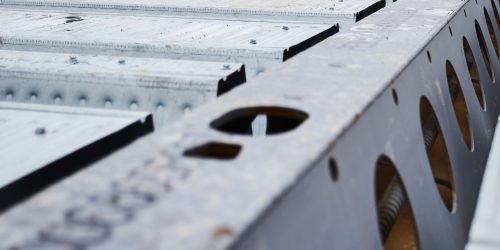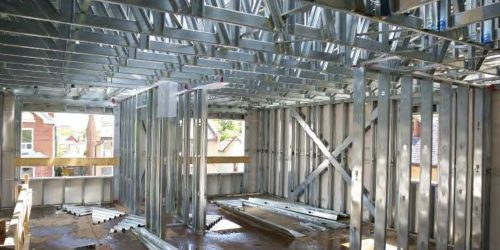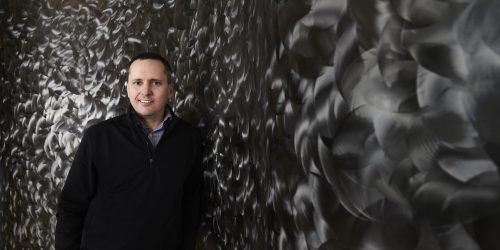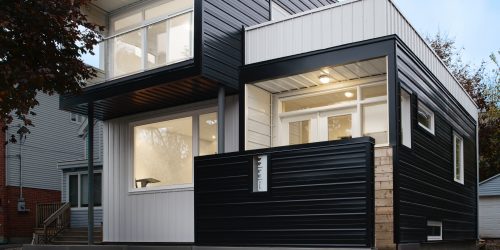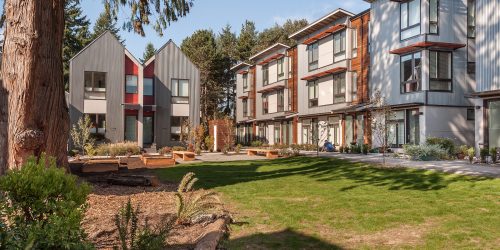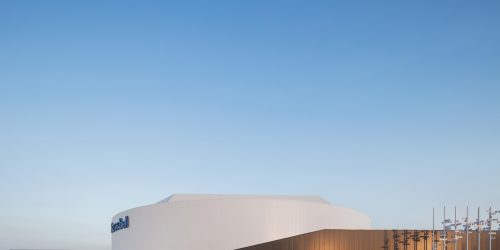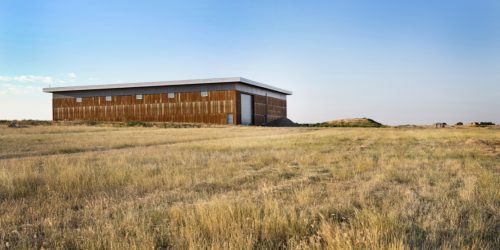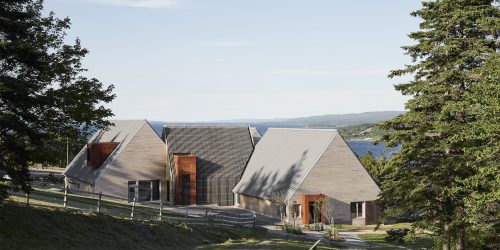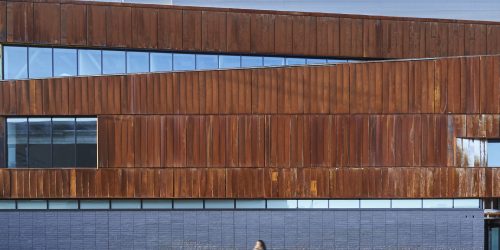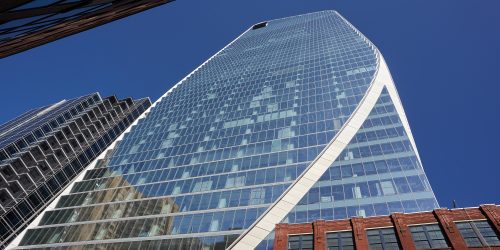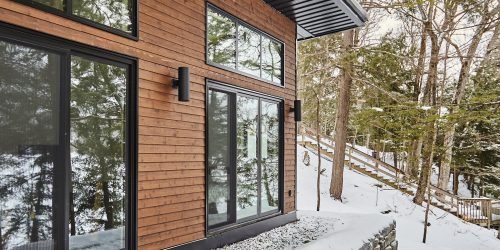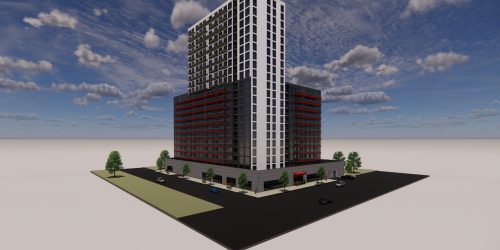The alchemy of water and steel
The Growing Market of Insulated Metal Panels in Aquatic Centres
Story: Julia Preston
Photography: David Boyer
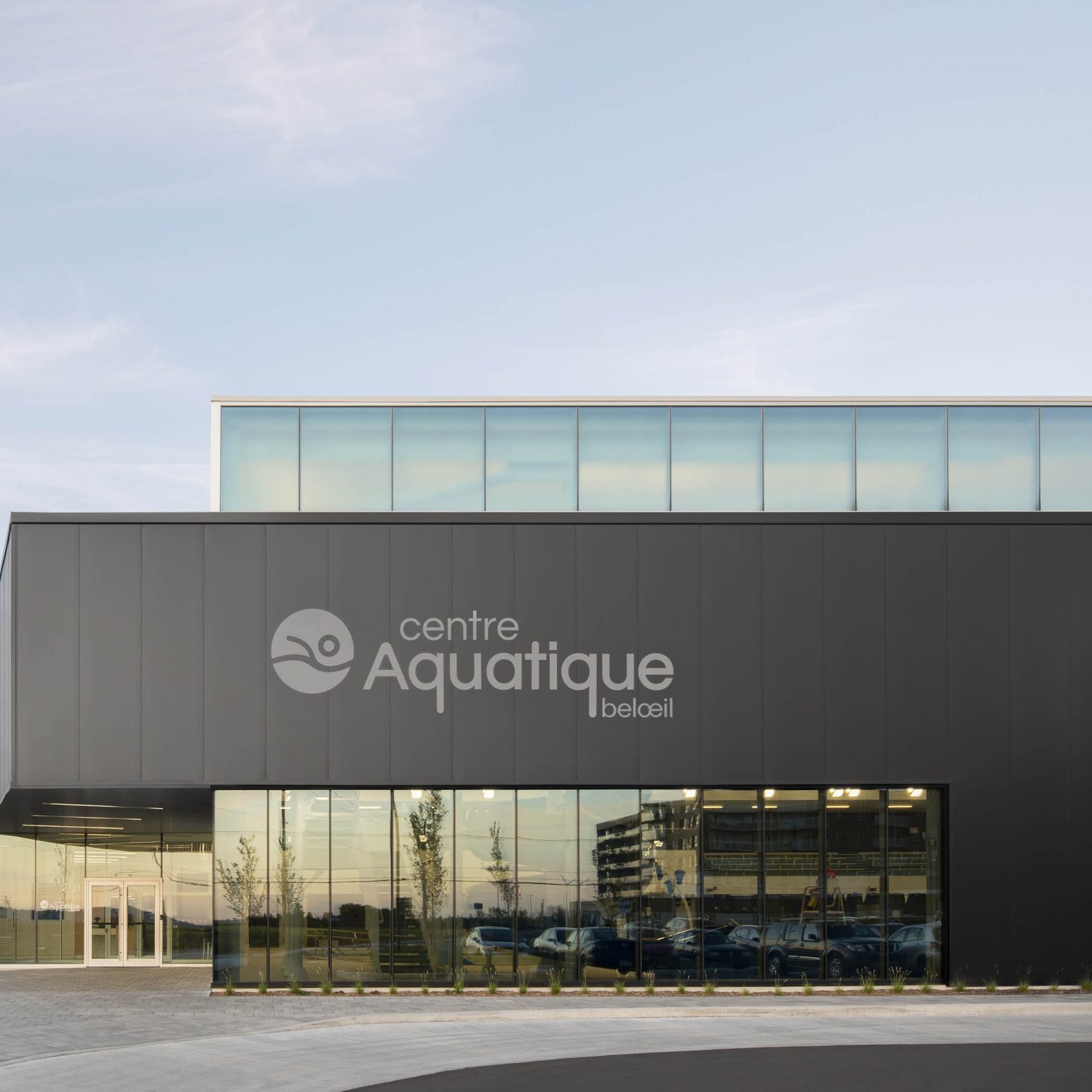
Beloeil, Quebec, southwest of Montreal, is tucked between Mont Saint-Hilaire and the Richelieu River and surrounded by agricultural fields. Beloeil’s new aquatics centre celebrates this unique setting through its architecture.
The centre was designed as “a translucent and luminous glass case set on a solid black base,” notes architectural firm Lemay. “Combining opacity and transparency, it embodies the contrast between the agricultural lands and the brightness of the sky that characterize the region.”
The solid black base that grounds the centre is composed of more than 16,000 square feet of insulated metal panels (IMPs) by Norbec.
The Beloeil centre is one of several aquatic centres constructed recently in Quebec using Norbec’s IMPs.
Insulated metal panels are a growing market in North America, says Alexandre Bélisle, Norbec’s director of R&D and Technical Services.
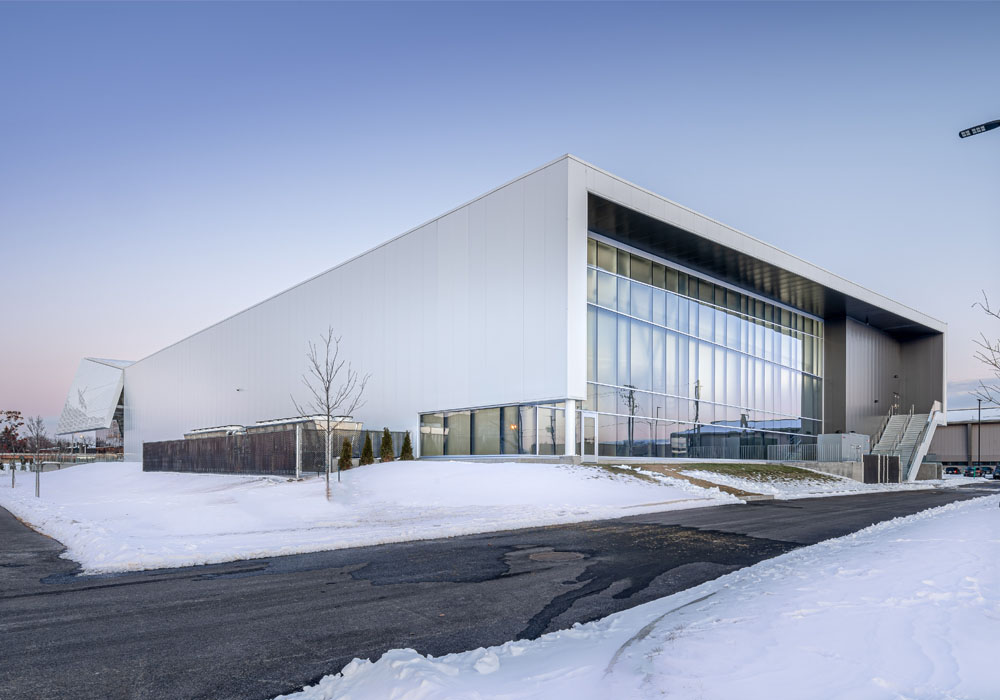
Brossard Aquatic Centre
Panels are made up of two metal faces—the interior and exterior face—sandwiched around a layer of rigid foam insulation (usually polyisocyanurate or PIR). Panel dimensions vary between manufacturers, but are approximately four feet wide. Norbec’s typical panel is 42.5 inches, to maximize the use of a full 48-inch steel coil notes Bélisle.
Other dimensions, along with horizontal, vertical, coloured, smooth and textured options, are also available.
For architect Alexandre Guérin who designed the Donnacona Aquatic Centre, the flexibility and versatility of IMPs make them an ideal material. “The different lengths of Norbec continuous panels and the few visible joints allow for a very clean finish,” he says.
Once the panels are installed, the building envelope is completed... It’s an all-in-one solution.
IMPs also speed up the construction process. “Once the panels are installed, the building envelope is completed,” says Bélisle. “There’s no need to have a lot of different contractors on site and do the insulation, then do the cladding, then do all the vapour barrier. It’s an all-in-one solution.”
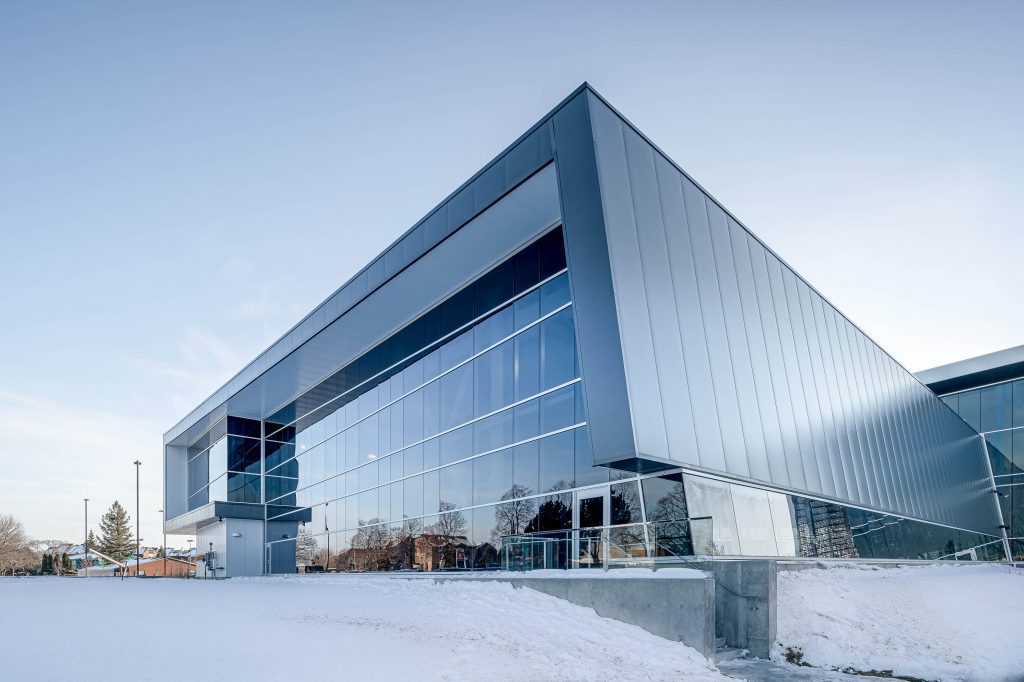
Brossard Aquatic Centre
When the panel installation is complete, interior work can begin.
Typically, the interior face of the panels will be covered with drywall or other finishes. But it can be left visible, as in Beloeil where the bright white interior helps to flood the complex with light.
IMPs increase efficiency during construction. They also improve energy efficiency over the long-term operation of a building.
The insulation core outperforms materials like wool, spray foam or polystyrene and helps keep operating costs and energy requirements to a minimum. IMPs can also help to balance large amounts of glazing.
“It is natural that they will use big windows to make the look and feel of the aquatic centre more open. But those windows will also play a role into bringing heat inside this building,” says Bélisle. “Where the IMPs will play a big role is in containing the heat inside the building and helping regulate this heat.”
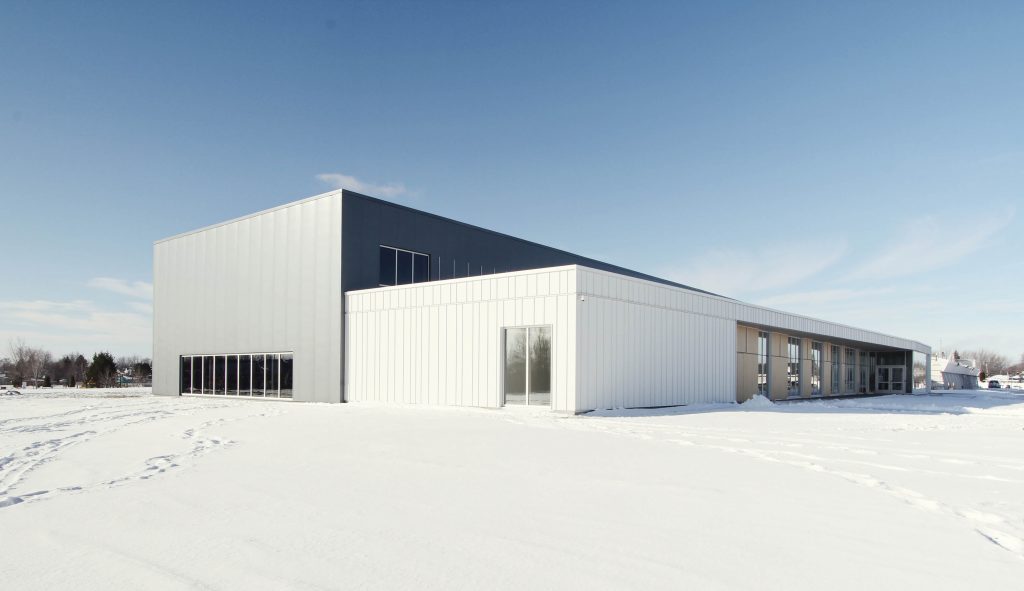
Donnacona Aquatic Centre
In Brossard, Quebec, architects Héloïse Thibodeau Architecte and Vincent Leclerc designed the aquatic centre to have full glass walls at either end. On the exterior side walls of the building, panels in dark grey and white give depth to the façade.
The width of the panels means fewer joints, making it easier to maintain the environment inside the building.
IMPs are often used to help meet requirements for LEED or other environmental building certifications.
“IMPs can play an important role in bringing those buildings to where they should be in 2021,” says Bélisle.
While IMPs have many benefits, using them in aquatic centres requires some extra considerations.
Indoor pools are typically a highly humid and potentially corrosive environment (depending on the water temperature, cleaning agents, water treatment chemicals, quantity of pool users, ventilation and other factors).
“These parameters are very different than the “normal” usage we see for our products—cold or temperate environments where the humidity level is somehow controlled,” explains Bélisle.
Corrosion resistant fasteners and finishes ensure that panels will not be damaged by water splashes or humidity.
“We recommend to seal all the panel joints (inside the pool area) to ensure there won’t be any water infiltration in the interior joints and this will also add an extra layer of protection in the panel joints for air infiltration,” says Bélisle.
For the comfort of users, the temperature in the pool area is higher than a typical interior space. In the winter, differences between interior and exterior temperatures can be significant. IMPs help to control temperatures, minimize heat loss and meet the building energy requirements.
“This high temperature differential in winter, added to the induced negative pressure environment inside the pool area, could promote condensation at the different building envelope junction interfaces. Extra measures are to be provided to counteract this risk,” recommends Bélisle.
Norbec has developed a deep expertise in aquatic facilities to support designers and architects throughout the design and construction process. Says Bélisle, “This support is backed by a good partnership with our suppliers and experienced installer network. We collaborate with them to ensure that no critical elements have been overlooked.”
BELOEIL AQUATIC CENTRE
ARCHITECT:
Lemay Architects // lemay.com
GENERAL CONTRACTOR:
Décarel // decarel.ca
INSTALLERS:
Distribution Styro Inc. // styro.ca
STEEL:
Product Used: Norex-L by Norbec
Panel Thickness: 4 in.
Interior Steel: Gauge: 26ga // Colour: Imperial White // Profile: Silkline (striated) // Finish: Smooth
Exterior Steel: Gauge: 22ga // Colour: Rigel 2 //
Profile: Micro-Ribbed // Finish: Smooth
BROSSARD AQUATIC CENTRE
ARCHITECT:
Consortium Héloise Thibodeau // htarchitecte.com
Vincent Leclerc + Associés architectes // vlarchitecte.com
GENERAL CONTRACTOR:
EBC Inc. // ebcinc.com
INSTALLERS:
Distribution Styro Inc. // styro.ca
STEEL:
Product Used: Norex-L
Panel Thickness: 4 in.
Interior Steel: Gauge: 26 ga // Colour: Imperial White // Profile: Silkline (striated) // Finish: Smooth
Exterior Steel: Gauge: 22 ga // Colour: Rigel 2 //
Profile: Microrib // Finish: Smooth
DONNACONA AQUATIC CENTRE
ARCHITECT:
STGM Architectes // stgm.net
GENERAL CONTRACTOR:
Dalcon // dalcon-inc.com
INSTALLERS:
Distribution Styro Inc. // styro.ca
STEEL:
Product Used: Norex-L
Panel Thickness: 6 in.
Interior Steel: Gauge: 24 ga // Colour: Advantica //
Profile: Silkline (striated) // Finish: Smooth
Exterior Steel: Gauge: 22 ga // Colour: Storm Grey //
Profile: Microrib // Finish: Smooth
